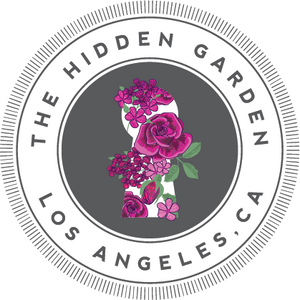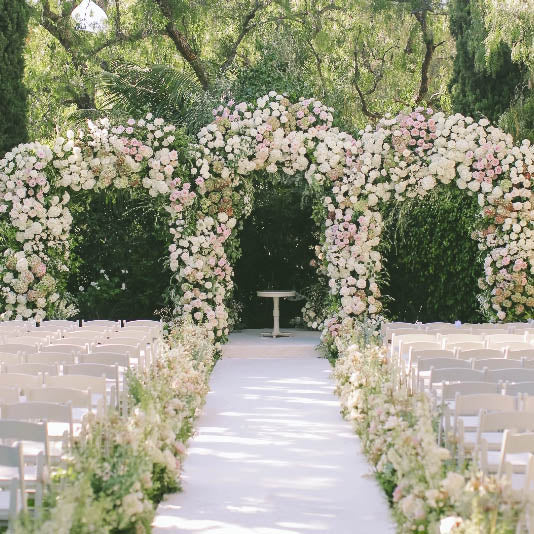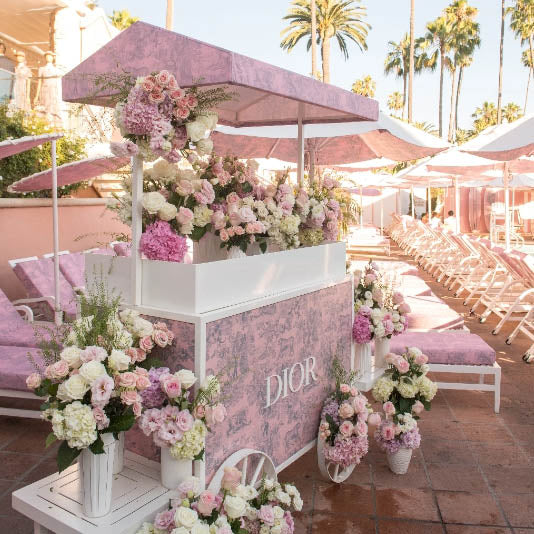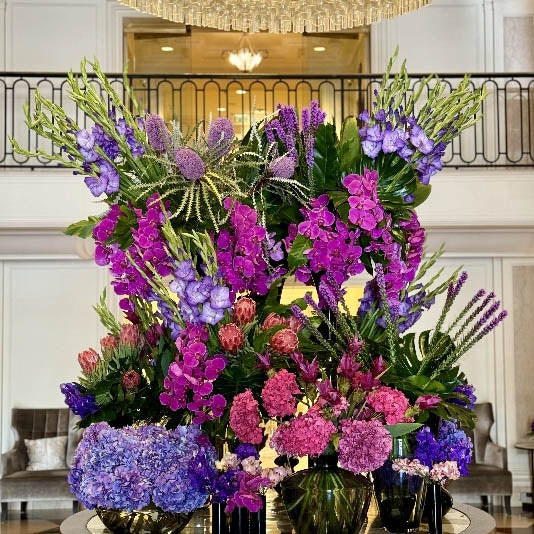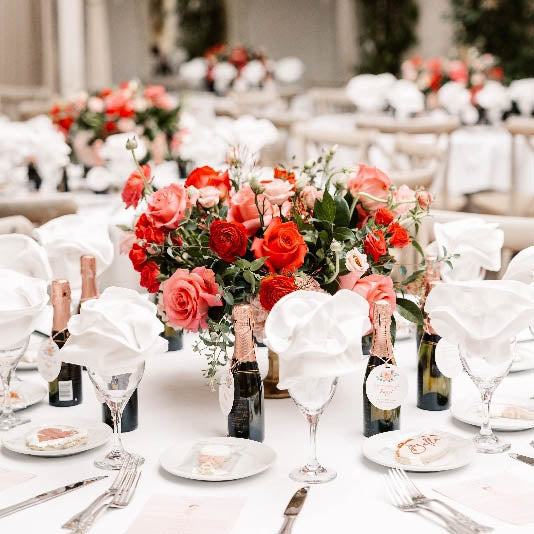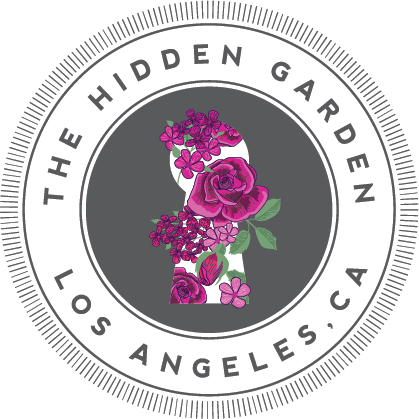
This guide gives you a full list of standout flowers that bloom in summer sorted by their color. For each shade, I’ve included my personal favorites. These are flowers I prefer and recommend most often during the summer season.
With over 25 years designing floral arrangements, I’ve learned what actually performs well and what just looks good in a photo. As the owner of Los Angeles florist The Hidden Garden, I build every recommendation in this guide from real experience, not theory.
Keep reading to learn which flowers define each summer color and how I use them to create summer flower arrangements for luxury clientele.
Blue Summer Flowers
| Agapanthus | Ageratum | Balloon Flower | Bachelor’s Button |
| Blue Salvia | Bluebeard | Delphinium | Evolvulus |
| Gentiana | Hydrangea | Lobelia | Love-in-a-Mist |
| Mealycup Sage | Perovskia | Tweedia caerulea | Veronica |
Our favorites: thistle, hydrangea, delphinium, larkspur
Hydrangeas

The Hidden Garden's Blue Serenity
The first real push of blue hydrangeas into American floral design came in the 1930s, once growers outside Japan started catching on to how soil acidity could shift their color. The blue flowers weren’t easy to find at the time. So once widely available, it gave designers an option that felt fresh and modern. By the time Jackie Kennedy was First Lady, she was bringing them into the White House to break up the stiff, overly formal arrangements that were the norm.
They bloom from late spring into August depending on the weather. What makes them dependable during summer is their structure. I’ve used them in outdoor installs under full sun and, when prepped correctly, they stay full and don’t collapse or discolor, even after hours on display.
What makes them practical in my work is their coverage. One stem fills a lot of space. If I’m building a floral arch or covering up mechanics, I can use fewer stems and still get the fullness I need. We use blue hydrangeas throughout our Blue Serenity arrangement pictured above.
Blue Thistle

Blue thistle is one of our favorite blue summer flowers because it has this incredible ability to stay crisp and structured for hours without needing much maintenance. I’ve worked with it plenty of times when timing was tight and prep had to be done well in advance, and I never had to circle back to fix or replace it.
It’s easy to pick out in a lineup. The flower has a tight, round core with stiff, narrow petals that radiate outward like a star. The shade falls between muted blue and silvery grey, which gives it a cool tone without being icy. Its stems are strong, and the jagged little leaves add just enough edge without distracting from the bloom.
I’ve added blue thistle to summer wedding flowers plenty of times. You’ll see it in boutonnieres, smaller accent arrangements, or as part of bouquets when they need more depth.
Delphinium

You’ll find delphinium thriving in cooler coastal climates, especially where the mornings stay misty and the soil drains well. It doesn’t love intense heat or dry air, but give it rich soil and consistent moisture, and it’ll shoot up tall with strong, vertical stems.
Delphinium stands for protection and honesty. The blue tones give it a sense of calm that feels steady, not soft. It doesn’t try to be sweet or emotional. It’s direct. When I include it in a design, I’m sending a message about trust, clear intent, and showing up for someone.
For summer, I love pairing delphinium with foxglove, sweet pea, and soft garden roses. That combination brings contrast in shape and tone, and the colors settle into each other without feeling repetitive.
Larkspur

Larkspur is the official July Birth Flower. It’s linked to honesty and connection, and people often ask for it because of that. If someone was born in July or wants a flower with personal meaning tied to that month, this is the one I reach for. It grows naturally through summer and is usually at its best when July rolls in.
Each stem is long and narrow, covered in small blue blooms that open in stages. The flowers are spaced apart just enough to keep it from looking dense. The color stays consistent along the stem, but the buds and open flowers give it variety in shape.
When clients are drawn to airy designs, Larkspur is usually part of the conversation. It’s especially prominent in unique flower arrangements when someone wants something visually striking.
Orange Summer Flowers
| Asclepias tuberosa | Calendula | California Poppy | Cosmos |
| Daylily | Gaillardia | Gazania | Helenium |
| Lantana | Marigold | Mexican Sunflower | Nasturtium |
| Snapdragon | Zinnia |
Our favorites: dahlias, zinnias
Dahlias

Orange varieties of dahlia have been around since the flower was first brought from Mexico to Europe in the late 1700s. What’s interesting is how quickly they moved from being seen as a botanical novelty to something people actively wanted in their gardens. The brightness of the orange cultivars became especially popular in the early 20th century, around the same time bold colors were showing up in fashion and home decor.
Their bloom period runs long. In Southern California, I see them starting in late spring and going well into early fall if the weather cooperates. They thrive in full sun and need consistent watering, but they don’t handle intense heat well, so placement matters. Mid-summer is usually when they look their best - making them a traditional August flower in my book.
For more information on summer flowers in California, follow the link to read our expert guide.
I like working with orange dahlias because. I can get strong color payoff and volume with fewer stems. The uniformity also makes it easier to cluster them or use them as a visual anchor.
Zinnias

Photo credit Flickr.
Zinnias grow best in warm, dry climates with plenty of sun and well-draining soil. I’ve had the most success with them when they’re planted in open areas where air can move freely around the stems. They don’t need much once they’re established, and they actually do better when you leave them alone.
Orange zinnias carry a meaning tied to friendship and optimism. The color orange brings energy. Gifting these zinnias communicates confidence and a reminder to stay positive.
I’d pair zinnias with gomphrena or scabiosa for a textural contrast, or with marigolds when I want a rich, tonal base. You can also pull in snapdragons for height, which balances the round shape of the zinnias without competing with the orange summer flower.
Pink Summer Flowers
| Astilbe | Begonia | Bleeding Heart | Cleome |
| Coneflower | Cosmos | Dianthus | Hollyhock |
| Impatiens | Lavatera | Peony | Phlox |
| Rain Lily | Rose | Sedum | Snapdragon |
| Spirea | Zinnia |
Our favorites: garden roses, dahlias, peonies, lisianthus
Garden Roses

The Hidden Garden's Youthful Love
Here’s something I always find fascinating about pink garden roses: they tend to smell stronger in the heat. You’d think summer might mute their scent, but it actually brings it out more. I notice it most when we’re prepping early morning installs and the room starts to warm up.
They have tightly packed petals that spiral from the center, creating a round, cupped shape. The heads are full, with some varieties opening to almost five inches across. Stems are strong enough to support the weight, which makes transporting and arranging them a lot easier. The shade of pink can range from pale blush to a more saturated tone depending on the grower.
Pink garden roses are one of the few roses that open gradually throughout the day without blowing out too fast, which matters when a wedding spans six or eight hours. I use them in bouquets because they’re tight in the morning but open just enough by the reception to look relaxed in photos.
You’ll also find pink garden roses featured in our Youthful Love arrangement. It’s a clean, romantic flowers design that highlights the shape and softness of the blooms.
Peonies

The Hidden Garden's Peony Pop
Pink peonies didn’t become a staple in floral design until American growers started producing reliable cut varieties like Sarah Bernhardt in the early 1900s. Before that, they were more of a garden flower in Europe, especially in France and England. Once farms figured out how to ship them without damage, they became a regular feature in weddings and high-end installs.
They bloom for about six weeks, starting in mid to late May. That short window is a big part of why they’re considered a luxury flower. They don’t adjust to your schedule. You have to plan around them. I hydrate them upright in deep water for at least twelve hours, then monitor the bloom speed by shifting their temperature gradually. If you rush it, they blow open and become unusable.
To learn more about keeping peonies fresh in a vase, use this guide from our floral care experts.
I use them when I need coverage without weight. The blooms are large but not heavy, so I can get fullness without stressing the mechanics. They hold well when conditioned correctly, and they don’t droop or twist once placed.
To see how peonies can take pink flower arrangements to new heights, take a look at our Peony Pop floral design.
Lisianthus
For a calm presence that softens palettes without washing them out, the pink summer flower I turn to is Lisianthus. Their color leans into warmth without turning peachy, which helps when I’m trying to thread different pink tones together in one design.
I use it in weddings when I want lift without using greenery. The way lisianthus leans and shifts gives the bouquet shape without going too loose. It also holds surprisingly well out of water, which helps during portraits or ceremony setups that run long.
In summer, I like to mix it with butterfly ranunculus or soft snapdragons. It keeps the line clean but gives just enough variation to make the shape feel intentional.
Purple Summer Flowers
| Aster | Balloon Flower | Bee Balm | Campanula |
| Catmint | Clematis | Coneflower | Foxglove |
| Gladiolus | Heliotrope | Lavender | Liatris |
| Salvia | Verbena | Wisteria |
Our favorites: lisianthus, purple vanda orchids, purple mokara orchids
Purple Vanda Orchids

Each bloom opens flat with thick petals and a dense network of veining that gives vanda orchids their structure. The purple varieties are vivid and saturated, and they stay open without folding or twisting. They feature heavily in our In Love with Amethyst arrangement, where the color anchors the entire piece.
Vanda orchids grow suspended in air, not soil, and take in moisture straight from humidity. That’s why they do best in tropical climates. Their peak season hits during summer when the warmth helps the blooms hold shape and color without softening or bruising.
Clients usually request purple flowers like vanda orchids when they want a strong focal point without needing extra layers. I combine them with calla lilies or roses and keep the design tight. They’re also one of the few orchids that thrives in full sunlight.
Purple Mokara Orchids
Tropical climates like Thailand, Malaysia and parts of Hawaii produce the strongest mokara orchids. They need warm air, consistent humidity and a planting base that lets their roots breathe. Growers use bark or coconut husk instead of soil because it holds moisture lightly while allowing air to circulate.
What sets mokaras apart from other purple summer flowers is that they carry a layered message. The orchid itself often signals admiration and when combined with that deep purple tone, it expresses a high amount of respect to the recipient.
In colorful summer flower designs I like pairing mokaras with rudbeckia or zinnias. Both have a flatter face and a more relaxed texture, which helps break up the polished surface of the orchid.
Lisianthus

The Hidden Garden's Violet Jewels
We’ve already covered lisianthus earlier, so I’ll keep this focused on what makes the purple summer flower variety distinct.
Purple lisianthus tends to open at a steadier pace than the lighter shades, which gives me more control when timing is tight. I don’t need to force them open or delay their use. They also handle water shifts well, so I can move them from prep to design without worrying about how they’ll respond.
In our Violet Jewels arrangement, I use purple lisianthus to cool the palette without interrupting the flow of the design. It helps smooth the transition between the more vibrant blooms and the neutral tones around them. I use it when the color mix feels close but not quite finished, and I need a small shift to pull the whole thing into place.
Red Summer Flowers
| Amaranthus | Bee Balm | Canna Lily | Celosia |
| Coleus | Dahlia | Dianthus | Fuchsia |
| Geranium | Gladiolus | Hibiscus | Lantana |
| Petunia | Poppy | Rose | Salvia |
| Zinnia |
Our favorites: peonies, ranunculus, garden roses
Peonies

The Hidden Garden's Petals of Romance
Another flower we’ve already covered so I’ll keep this one short. I rely on red Peonies in summer flower designs because they always bring a wow factor without needing much else.
You’ll find them in our Peony & Rose Bouquet, which we call Petals of Romance. I built it around rich red peonies paired with wide garden roses, giving it a dramatic yet romantic feel. Peonies are a luxury flower and in this arrangement they bring that unforgettable presence people never forget.
Ranunculus

The Hidden Garden's Garden Love
An interesting fact I love mentioning, in Victorian floral language giving ranunculus sent a clear message: I’m dazzled by your charms. And before that, Persian legend linked these blooms to a lovesick prince transformed into ranunculus for his devotion.
Ranunculus bloom from late spring into summer, and they’re grown as cool‑season perennials in milder zones or summer bulbs that started early elsewhere. They thrive under full sun or partial shade, their layered petals unfurl as temperatures warm making them a true red summer flower standout.
Ranunculus carry a long history of meaning, especially in wedding bouquets. They’ve symbolized charm and deep admiration for centuries, which makes them a natural fit for romantic celebrations.
Take a look at our Garden Love design. Red ranunculus are woven between the roses to bring shape and contrast. It’s structured, thoughtful and ideal when you want your flowers to feel polished.
Garden Roses

The Hidden Garden's Infinite Love
I’ve spent countless summers arranging red garden roses for weddings, and I still feel a little thrill when I see them carried down the aisle. These blooms are beloved because they speak of deep romantic love in a way that feels timeless. Their lush petals and soft fragrance wrap around a bride’s bouquet like a warm embrace
When I designed Infinite Love, I chose two dozen richly colored red roses and nestled them among dramatic anthurium, sculptural cymbidium, and fan‑style flax leaves for structure and contrast. The roses draw your eye, the cymbidium lifts the shape and anthurium adds a refined tone.
Giving Infinite Love makes sense for a milestone, think flowers for anniversaries or heartfelt romantic gestures.
White Summer Flowers
| Alyssum | Bacopa | Candytuft | Cosmos |
| Daisy | Gaura | Hydrangea | Jasmine |
| Lily | Moonflower | Nicotiana | Phlox |
| Queen Anne’s Lace | Rose | Sweet Pea | Vinca |
| Yarrow |
Our favorites: cosmos, zinnias, garden roses
Cosmos

White cosmos are part of the same family as sunflowers, which always fascinates people. You’d never guess it just by looking at them, but they’re botanical cousins. That little detail tends to catch the attention of clients who love a flower with a bit of backstory.
They’re tall and thin, with clean white petals that flare out evenly from a bright yellow center. The leaves are feathery and sparse, which helps the flower feel light and natural. They move easily in a breeze and look best when they’re allowed to stretch a little above the rest of the design.
Most of the time when we include cosmos, it’s because a client wants the arrangement to feel a little wild but still have meaning. They work especially well in loose, summer seasonal pieces that need some breathing room. They also pair well inside pink and white flower arrangements.
Garden Roses

The Hidden Garden's Pure Timeless
We love garden roses and we keep coming back to them time and time again, especially so when we need a white summer flower that signifies elegance. Pure Timeless uses twelve white roses arranged low in a clear glass vase. I added lisianthus between the blooms to break up the surface and eucalyptus around the edges to keep it from looking boxed in. There’s no filler and no extra color. Clients usually order this for condolence deliveries, professional settings, or when they want to keep things simple and formal.
Yellow Summer Flowers
| Black-eyed Susan | Calendula | Coreopsis | Daylily |
| Heliopsis | Helianthus | Marigold | Rudbeckia |
| Snapdragon | Strawflower | Sunflower | Tithonia |
| Yarrow | Zinnia |
Our favorites: cosmos, lisianthus, zinnias
Cosmos

We’ve already talked about cosmos, but not the yellow summer flower ones. Their stems grow taller and bushier than the white types and they bloom fast, usually just 50 to 60 days from seed, which makes them one of the quickest seasonal growers in summer.
The people who request them usually prefer arrangements that look relaxed and unforced, with movement through the lines rather than strict rigidity.
Zinnias

I use yellow zinnias when I need a flat-faced flower that fills space without overlapping or dropping petals. They work best in clustered designs where I want a clean break between textures. I don’t mix them with too much ruffle. Clients who like sharper outlines or structured garden-style pieces tend to ask for these in summer mixes.
